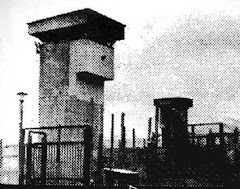
Held in the notorious jail in the 70s, Ronan Bennett recalls the gas attack, beatings, smell and the jokes.
The sky was low and grey and the smoke from last night's fires hung in the air. I was in the middle of the first football pitch. There was a lot of noise and movement and I didn't know which way to run or what I was doing or what I was supposed to do. We had been drawn up in companies and squads, ready to fight back. But with the first of the gas communication had broken down completely. The helicopter banked again into position and the next canister was dropped. There was a small explosion in the air, perhaps 20 or 30 metres above us, as the canister splintered and the shower of bomblets announced themselves with an individual billow of white smoke, pushing gracefully out in all directions and hanging in the air for a moment like some vapoury spider before beginning their descent.
The panic gas induces temporarily overthrows everything you think you are, or hope you might be. It's the violent desperation of a drowning man who will clutch at anything, even a child, even his own child. With gas, courage certainly goes. So does any sense of solidarity, the thing of which Long Kesh's republican prisoners were so proud. When you are fighting for breath, tears streaming down your face, snot in your nostrils and bile in your mouth, it becomes every man for himself. The two football pitches in the middle of the vast prison complex were separated by a wire fence, in the midpoint of which was a gate the size of your front door. It was on this door that my attention was fixed. I wanted to get through it and into the other, gas-free, pitch. Unfortunately so did the hundreds of gasping, spewing, half-blinded men I was among. Passage was fiercely contested. Once through, respite was brief. The helicopter simply made the short hop and more canisters came down. Most of us had had experience of CS gas before prison, on civil rights marches or in riots. Later there were rumours that the soldiers had used the more potent CR variant, such was the reaction it brought in the men, though perhaps this was merely the result of a new intensity of saturation.
We headed in a wave back the way we came, through the door, shorter of breath, seeing less. The helicopter followed patiently, so did the gas, and we doubled back again. I can't now recall how many times this happened, but I do remember towards the end stumbling over someone who had fallen in the scrum: he was calling for his mother. Some prisoners fought on, jabbing at the soldiers in their riot gear, batons and shields with broom handles and bits and pieces of whatever debris of the smouldering jail they could lay their hands on and hurl. They were a tough crew, but in the end they too surrendered. We were herded back to our cages and the beatings began.One thing I've learned is that if you're going to burn down a prison you should do it in the spring.
This was October, 1974, and for the next few weeks we lived out in the open, or in crude, post-apocalypse shelters salvaged from the wreckage. Our hair grew and our beards sprouted. We hauled the covers from the manholes and crapped directly into the sewers. We probably didn't smell very good, but when everyone smells bad you don't notice so much. We wore grey blankets as ponchos, cutting a slit in the middle for our heads to go through. We huddled together against the cold and sang songs, told jokes and talked endlessly about politics and what the future might hold. Sometimes we just messed. One night a kind of collective and spontaneous silliness overtook our cage and a hundred grown men started playing tag and hide and seek. I was laughing so much I couldn't run and was one of the first to be caught.Gradually conditions improved and the rhythms of Long Kesh life re-established themselves: exercise and visits; court appearances and football; Irish classes, letters and reading.
Ronan Bennett was born on 14 January 1956 in Belfast, Ireland. He was educated at King's College, London, and was a research fellow at the Institute of Historical Research in London from 1986-7.His first novel, The Second Prison (1991), a thriller about a member of a group of Irish republican activists, was shortlisted for the Irish Times Irish Literature Prize for First Book. His second novel, Overthrown by Strangers (1992), is set in Latin America. The Catastrophist (1997), the story of an Irish journalist working in the Belgian Congo in the 1950s, won the Irish Post Literature Award and the Belfast Arts Award for Literature and was shortlisted for the Whitbread Novel Award. Havoc, in its third year (2004), is an historical novel set in 17th-century England. It won the 2004 Hughes & Hughes/Irish Independent Irish Novel of the Year. Zugwang (2007), was published in serial instalments in The Observer over seven months in 2006.
The author has also written screenplays for film and television, Face, starring Robert Carlyle and Ray Winstone, Love Lies Bleeding, starring Mark Rylance, and Rebel Heart. He wrote the screenplay for the film Lucky Break, a prison escape comedy released in 2001, and co-wrote the controversial BBC eco-thriller, Fields of Gold. He also recently wrote the screenplay for Hamburg Cell, a docu-drama about the men who planned and carried out the 9/11 attacks.Ronan Bennett is a regular contributor to The Guardian and The Observer.









